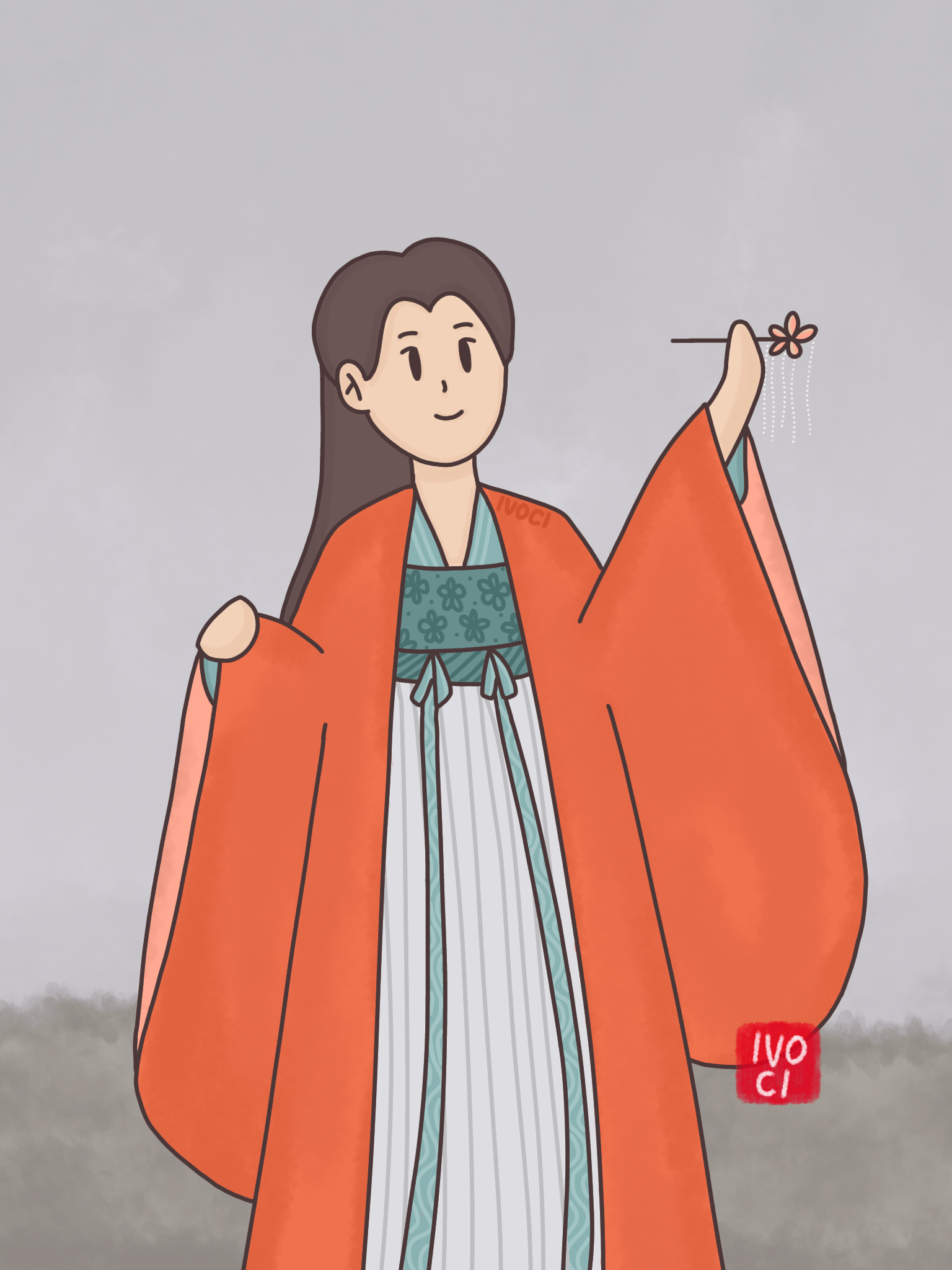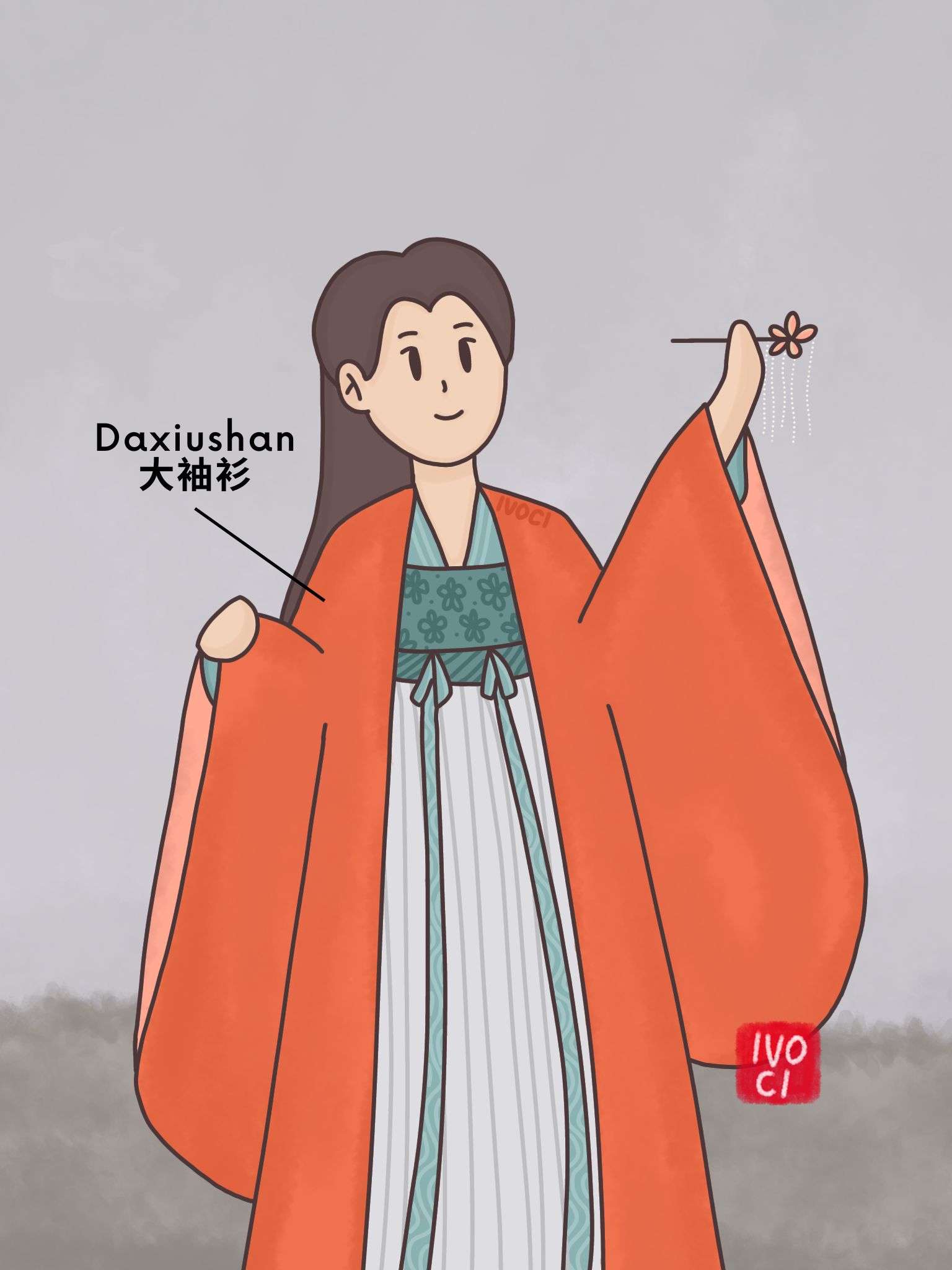Daxiushan (Chinese: 大袖衫 ; pinyin: dà xiù shān) which means big sleeve robe is a traditional Chinese outer garment, with wide sleeves.
Daxiushan can also be referred to as dianchailiyi (Chinese: 钿钗礼衣 ; pinyin: diàn chāi lǐ yī) and dashan (Chinese: 大衫 ; pinyin: dà shān) or daxiu (Chinese: 大袖 ; pinyin: dà xiù) in the Ming dynasty.
Daxiushan was most popular during the Tang dynasty, especially among the royals.
Daxiushan was originally men’s clothing in the Wei and Jin dynasties, but in the Tang dynasty, it referred to women’s wide sleeve dresses.
Daxiushan can be with a central front collar or dui-jin, long sleeves, and with slits and straps.
After the Tang dynasty, the daxiushan also continued to be used in the Song and Ming dynasties.
History
Tang Dynasty and Five Dynasties & Ten Kingdoms
After the golden age of the Tang dynasty ended, the influence of Hufu, a clothing style from Central and West Asia, gradually weakened and the styles of clothing of the royal ladies of the Tang dynasty began to make their transformations more broad and loose.
It was not until the Middle and Late Tang Dynasty (中晚唐时期) period that the differences between royal women’s clothing and other styles became clearer.
The width of the sleeves worn by ordinary women often exceeded 4 feet in the late mid-Tang dynasty.
In the Tang dynasty, daxiushan was often combined with qixiong ruqun.
Song Dynasty
Daxiushan was originally worn by empresses and imperial concubines as their common attire.
However, it was later adopted by also worn by noblewomen who used it as part of their ceremonial attire.
Commoners were not allowed to wear daxiushan and had to wear beizi (Chinese: 褙子 ; pinyin: bèi zi) instead.
In both the Song and Ming dynasties, the daxiushan had a San Jiao Dou (三角兜, triangular pocket) on the back or short in front and long in the back.
As a high-specification Lifu or Jifu, the daxiushan should be worn with xiapei plus peizhui or commonly known as xiapeizhui (Chinese: 霞帔坠 ; pinyin: xiá pèi zhuì).
Ming dynasty
In the Ming dynasty, daxiushan was known as dashan (Hanzi: 大衫 ; pinyin: dà shān) or daxiu (Hanzi: 大袖 ; pinyin: dà xiù).
The yellow dashan was worn by the Huanghou (Chinese: 皇后 ; pinyin: huáng hòu) or empress, while the red dashan was worn by the women of the imperial clan, which could include Huangfei (Chinese: 皇妃; pinyin: huáng fēi) or imperial concubine, Huangtaizifei (Chinese: 皇太子妃; pinyin: huáng tài zǐ fēi) or crown princess, Qinwangfei (Chinese: 亲王妃; pinyin: qīn wáng fēi), and Junwangfei (Chinese: 郡王妃; pinyin: jùn wáng fēi).
Daxiushan related paintings
《簪花仕女图》 or “Court Ladies Wearing Flowered Headdresses”, was painted by Tang Dynasty painter Zhou Fang with simple brush strokes.
Now in the Liaoning Provincial Museum, the painting depicts a scene of noblewomen enjoying flowers in the garden at the turn of spring and summer, and the image depicts a woman’s relaxed life.
The long dress or daxiushan was the attire of noble women at that time. Fashionable high bun with large peonies in the hairpin and jasmine flowers at the bottom. With black hair, looks elegant, clean, and bright.
The painting depicts a scene of a noblewoman walking in the courtyard picking flowers and catching butterflies.
The character’s clothing in the picture is different from other Tang dynasty portraits, such as using a large flower decoration on the head and wearing a daxiushan combined with a pibo.
Judging from the many pottery statues found during the mid and late Tang dynasty, the women’s clothing in the paintings truly reflects the fashion culture of women at that time.



